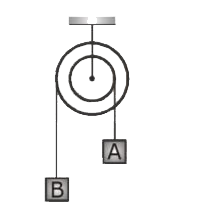A 0.6 m radius drum carrying the load A is rigidly attached to a 0.9m radius pulley carrying the load B as shown. At the time t = 0, the load B moves with a velocity of 2m/s (downward) and a constant acceleration of 3m/s2 (downward). Over the time interval 0≤t≤2s , determine
The number of revolution executed by the pulley and the displacement of the load A.

1003π,203m
509π,203m
509π,103m
259π,203m
The correct Answer is:B
Step by step video & image solution for A 0.6 m radius drum carrying the load A is rigidly attached to a 0.9m radius pulley carrying the load B as shown. At the time t = 0, the load B moves with a velocity of 2m/s (downward) and a constant acceleration of 3m/s2 (downward). Over the time interval 0 le t le 2s , determine The number of revolution executed by the pulley and the displacement of the load A. by Physics experts to help you in doubts & scoring excellent marks in Class 12 exams.
Updated on:21/07/2023Topper's Solved these Questions
- 10 ROTATIONALBOOK - MOTIONCHAPTER - 10 ROTATIONALEXERCISE - Exercise - 2 (Level -I)
51 Videos
- 10 ROTATIONALBOOK - MOTIONCHAPTER - 10 ROTATIONALEXERCISE - Exercise - 2 (Level - II)
25 Videos
- 10 ROTATIONALBOOK - MOTIONCHAPTER - 10 ROTATIONALEXERCISE - Example 31
1 Videos
- ALTERNATING CURRENTBOOK - MOTIONCHAPTER - ALTERNATING CURRENTEXERCISE - EXERCISE - 4 (LEVEL - II)
14 Videos
Similar Questions
Knowledge Check
At time t=0 s a car passes a point with velocity of 16m/s and thereafter slows down with acceleration a=−0.5tm/s2 ,where t is in seconds. It stops at the instant t=
A32sB16sC8.0sD4.0sFor the pulley system shown in fig. each of the cables at A and B is given a velocity of 2ms−1 in the direction of the arrow. Determine the upward velocity v of the load m.
 A1.5ms−1B3ms−1C6ms−1D4.5ms−1
A1.5ms−1B3ms−1C6ms−1D4.5ms−1If acceleration of block B is 4m/s2 upward & that of C is 6m/s2 downward. Find acceleration of A :−
 A2m/s2 upwardB1m/s2 upwardC1m/s2 downwardD2m/s2 downward
A2m/s2 upwardB1m/s2 upwardC1m/s2 downwardD2m/s2 downward
Velocity of a particle at time t=0is2m/s. A constant acceleration of 2ms2 acts on the particle for 2s at an angle of 60∘ with its initial velocity. Find the magnitude of velocity and displacement of particle at the end of t=2s.
View SolutionSuppose that a particle mvoes on a straight line so that is velocity at time t is v(t)=(t2−2t)m/s.
(a). Find the displacement of the particle during the time interval 0≤t≤3
(b). Find the distance traveled by the particle during the time interval 0≤t≤3.
View SolutionA pulley fixed to the ceiling of an elevator car carries a thread whose ends are attached to the masses m1andm2. The car starts going up with an acceleration a0. Assuming the masses of the pulley and the thread as well as the friction to be negligible, find:

(a) the acceleration of the load m1 relative to the elevator shaft and relative to the car
(b) the force exerted by the pulley on the ceiling of the car. Given m1>m2.
View SolutionVelocity and acceleration of a particle at time t=0are u=(2ˆi+3ˆj)m/sanda=(4ˆi+3ˆj)m/s2 respectively. Find the velocity and displacement if particle at t=2s.
View SolutionA body moves with uniform velocity of u = 7 m/s from t = 0 to t = 1.5 sec. For t gt 1.5 s, it starts moving with an acceleration of 10 m/s2. The distance travelled between t = 0 to t = 3 sec will be -
View Solution

